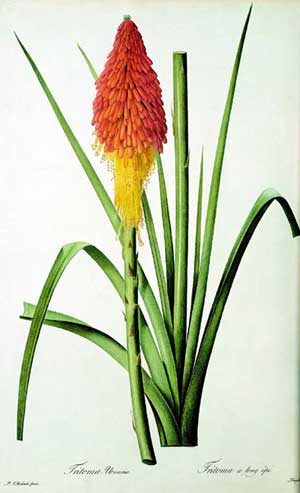
The Romanticism of Flowers
Paintings and prints by Pierre-Joseph Redouté at the New York Botanical Society
By Maureen Mullarkey
We moderns cherish the assumption that legibility and accuracy are extraneous to aesthetic value and—as residual Freudians suspect—might even undermine it. Botanical painting’s cunning reconciliations between canonical specificity and expression escape us. But Pierre-Joseph Redouté (1759-1840) lived when art and science had not yet diverged and documenting the visual world was still an artist’s crucial role. It was the golden age of botany, of French scientific draughtsmanship and French flower painting.
 |
| From "Liliácees" |
Celebrated in his lifetime, Redouté remains the most popular painter in the history of botanical art. This wisely selected, engaging exhibition at the New York Botanical Garden, showcases all of his major work, including Les Roses and Les Liliácees, which record plants grown at Empress Joséphine’s Chateau Malmaison, a horticultural splendor of vineyards, woodlands, grain fields, gardens, and tropical rarities. Vivid context is provided by works of the artist’s mentors and his students who, as collaborators or competitors, also produced important books and prints.
Born in Belgium, Redouté and his two brothers learned to paint from their father, a specialist in portraits and decorations. Confident in his skills, Redouté packed his knapsack at 13 and set out across Begium and Holland in search of work. He studied wherever he traveled, though his most formative experience was in Amsterdam where the great floras of Jan van Huysum (1682 -1749) charged his imagination and shaped his ambition.
At 23, he moved to Paris to design stage scenery with his older brother. There, he met the two men crucial to his future: Gerard van Spaendonck (1746 -1822), a virtuoso floral painter and follower of van Husyum; and the botanist Charles-Louis L’Héritier (1746 -1800), a wealthy aristocrat and die-hard Linnæan who taught him flower dissection and the protocols of scientific representation. On the cusp of the French Revolution, Redouté was appointed—likely on L’Héritier’s recommendation— Draughtsman to the Cabinet of Marie-Antoinette. Redouté managed to hold onto his head during the Terror and, afterward, found a lavish patron in Joséphine Bonaparte. Surrounded by horticulturists, she stocked Malmaison with exotic plants from all over the world. (Her gardeners carried dual passports so they could continue to shop across borders during the Napoleonic wars.) Redouté recorded the gardens and their scores of species previously unknown in Europe. Among them were the dahlia, camellia, eucalyptus, catalpa, tulip tree, hibiscus, purple magnolia, Louisiana cypress, yellow roses and the tree peony.
The natural sciences generated great popular excitement in Redouté’s day. Knowledge of the botanical world, of its chemistry and fecundity, was expanding with breathtaking speed. His age was still giddy over the recently observed process of photosynthesis, which sparked understanding of the importance of plants and their leaf structures. (Joseph Priestley jump-started ecology in the 1770s. He was first to note that without leaves we wouldn’t be here.) New knowledge of plant physiology contributed to the Romantic Movement’s assertion that the Universe speaks to Man through Nature, its utterances as audible in the stamens of a lily as in the song of a skylark. The temper of Redouté’s times found expression in Wordworth’s address to the daisy: “Methinks that there abides in thee / some concord with humanity.”
Romanticism’s impact on sensibility is evident in the mood of Redouté’s realism. Wildflowers and woodland species—every “unassuming commonplace of nature”—are treated with the same regard as Josephine’s 200 varieties of proud roses. Jean-Jacques Rousseau would have approved. Painted from life, blossoms turn demurely aside or lower their heads in modesty. Compositions become character studies as well as analyses of structure. Gentle turns of the floral axis keep bold frontality from intruding on the melancholy languor of “nectared sweets” grown in gardens where Keats might recognize “weeds of glorious feature.” (Redouté is called the Raphael of flower painting but you come closer here to Keats than to Raphael.)
His luminous watercolor bouquets for Josephine are marvels of animated rigor and First Empire elegance. A “Bouquet of Roses and Double-Flowered Anemones” (1813) displays the compound leaf pattern and bud structure of the rose against three anemones in various stages of bloom. The shadow of one pale blossom on another distributes the value scale while it dramatizes the solidity of delicate elements. You can feel the weight of them in the palm of your hand.
An opium poppy turns its face completely away, shunning its own outlaw seed pod. (Frightened of addiction, France forbade opium sales a century earlier.) Elsewhere, a graceful lilac sprig is empearled with dew drops, a nod to literate audiences sympathetic to Shelley’s Sensitive Plant that wept at winter’s coming. (Redouté sought clients on both sides of the Channel.) An occasional moth or butterfly alights, a color note that honors natural pollination routes and simultaneously suggests the poignance of fleeting beauty.
A rare oversized folio opens to one of Redouté’s most splendid stipple engravings: a characteristic Chinese tree peony. Its leaves are spread, within the bounds of botanical possibility, to satisfy the composition and display habits of growth. The riot of petals is unified into a tapestry of brilliant tonal shifts, evidence of Redouté’s sensitivity as a colorist and his mastery of a printing technique that permitted greater transparency and naturalism than traditional line engraving. The folios on view are treasures in themselves. (These are often bought at auction, stripped of their bindings, and the plates sold off singly—an art world variant of commodity arbitrage. Or, if you prefer, vivisection.)
This show is a rare treat for lovers of the genre and a delightful introduction to those new to a vivaceous art form that boasts its own history, progression of standards, masterpieces and subtleties of expression.




“Flowers by Redouté: Artist for an Empire” at The New York Botanical Garden,The LuEsther T. Merz Library (Bronx River Parkway & Fordham Road, 718-817-8874 or 8700).
This essay first appeared in The New York Sun, December 1, 2005.
Copyright 2005, Maureen Mullarkey







